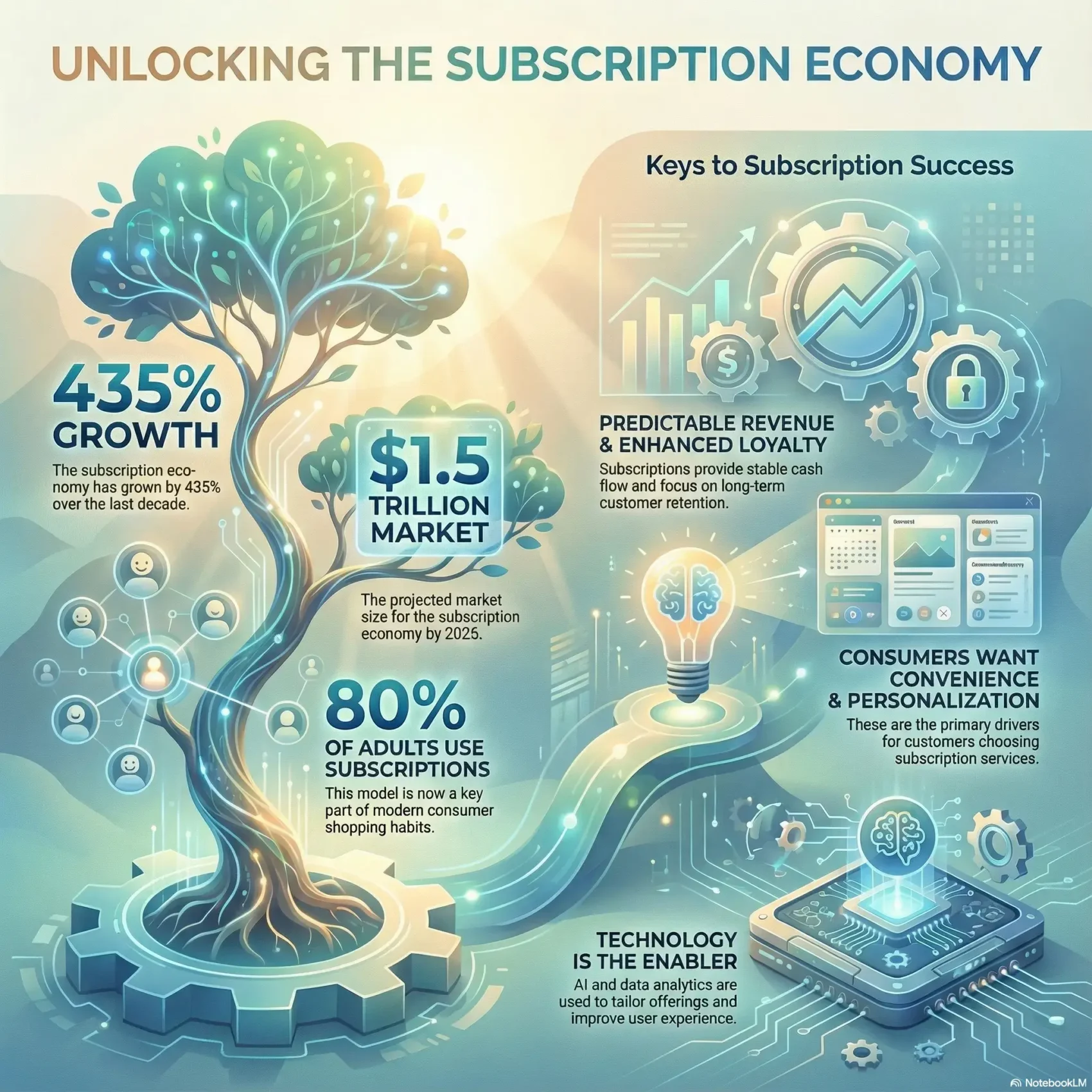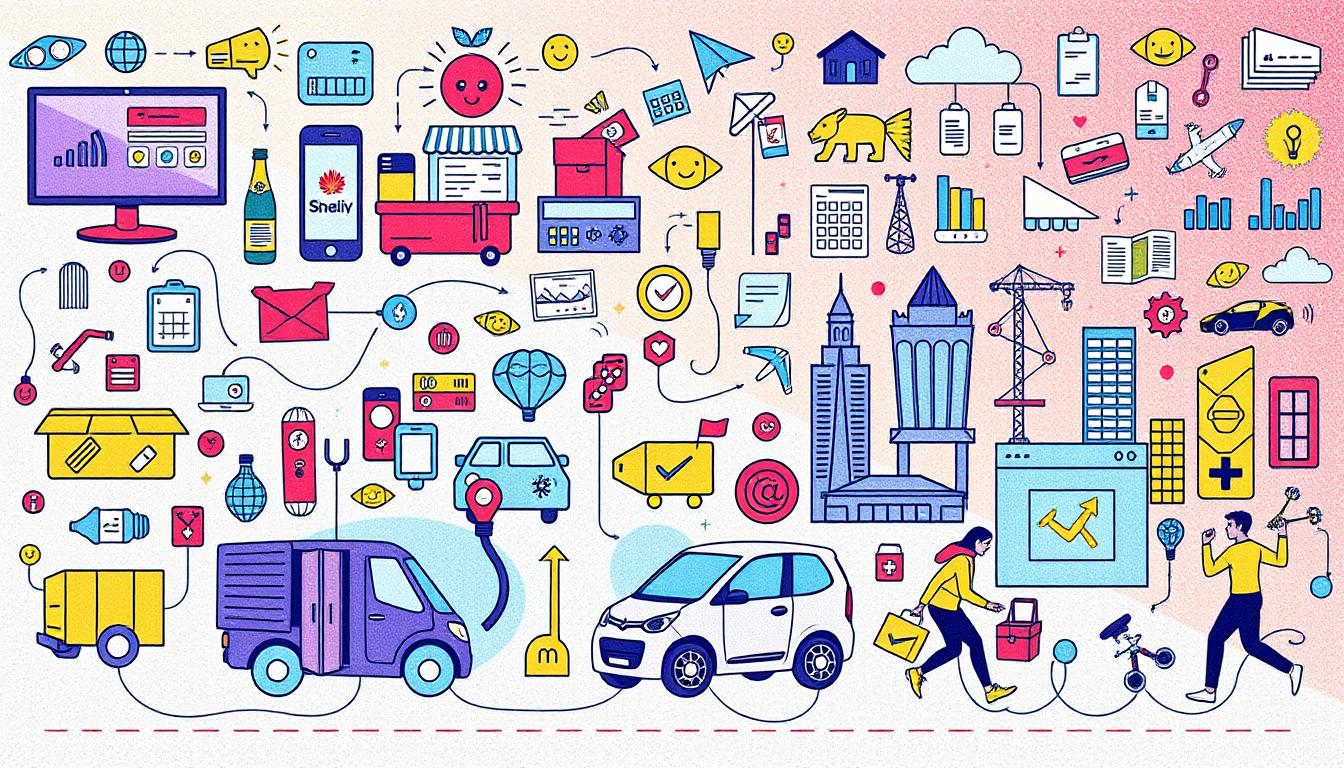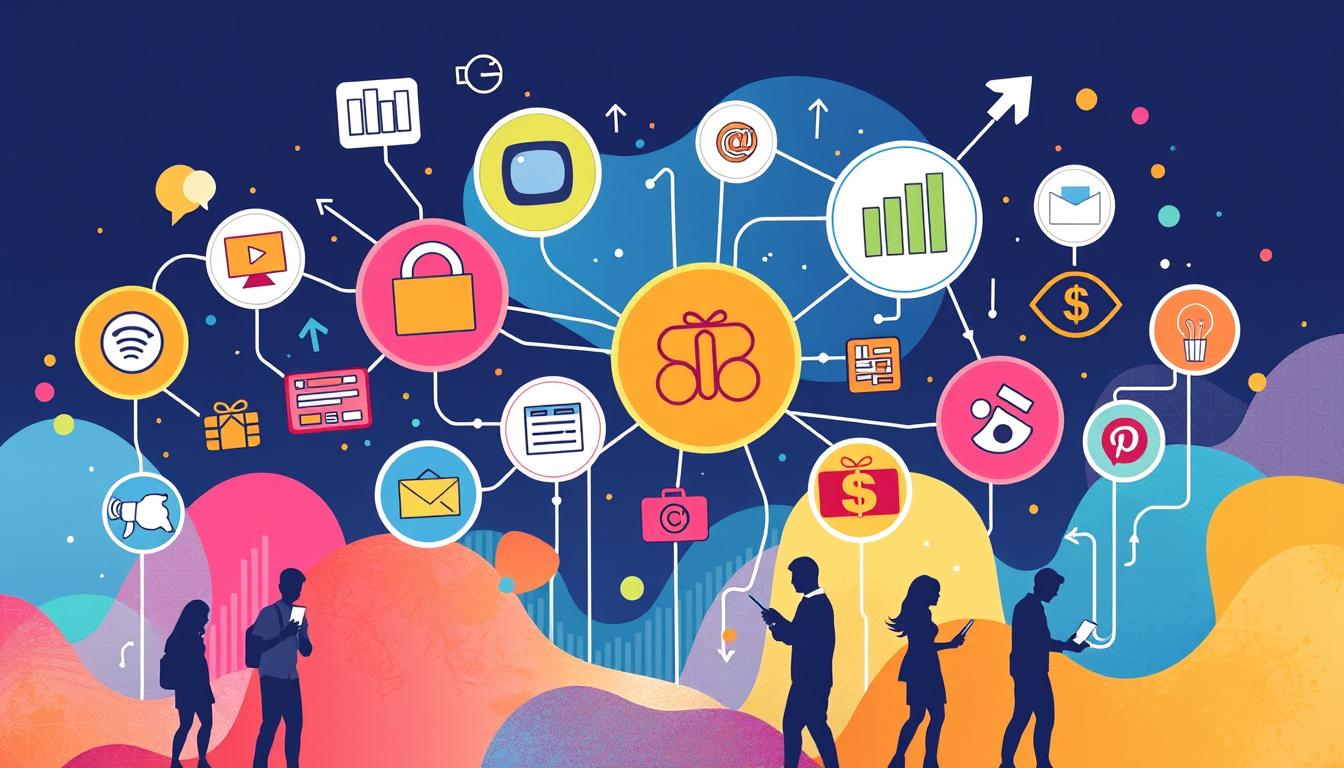Last Updated on December 13, 2025
The subscription-based business model has seen a significant rise, changing how companies make money. Over the last decade, the subscription economy has grown by 435 percent. It’s expected to reach a massive market size of $1.5 trillion by 2025. Now, companies across sectors like entertainment, food, and fitness offer ongoing access to their products and services for a recurring fee.
This shift benefits businesses by providing steady revenue streams. It also meets your need for convenience and personalization. As consumers, we now seek experiences that improve our lives, fostering brand loyalty and engagement. Businesses can thrive by understanding these subscription trends. They can use innovative pricing and community-building to leverage the recurring revenue model.
Key Takeaways
- The subscription economy market is projected to hit $1.5 trillion by 2025.
- Consumers spent an average of $273 monthly on subscriptions in 2021.
- Predictable revenue and ongoing engagement are key advantages for businesses using this model.
- Success relies on understanding various subscription pricing strategies.
- Brand loyalty and customer retention are easier with tailored experiences.
Understanding the Subscription Economy
The subscription economy marks a shift towards recurring revenue models, creating lasting customer connections. Businesses now favor subscription services for their predictable income and enhanced customer experiences. This shift benefits both companies and consumers, aligning with their evolving needs.
Definition and Overview
Businesses are redefining their customer interactions in the subscription economy. A Gartner study predicted by 2015, 35% of Global 2000 companies would generate revenue through subscription-based services. Over half of businesses surveyed by The Economist, commissioned by Zuora, are changing their pricing to adopt subscriptions. This shift moves away from traditional transactional models to a recurring revenue model, offering flexibility and convenience.
Characteristics of the Subscription Model
Key features make the subscription model appealing:
- Predictable cash flow: Companies can more accurately forecast revenue, attracting investors and management.
- Customer retention emphasis: Focusing on loyalty keeps consumers engaged and satisfied with their services.
- Convenience: Subscription services provide user-friendly platforms and personalized experiences, boosting customer satisfaction.
The subscription economy is set for significant growth, potentially reaching $1.5 trillion by 2025. This growth reflects businesses adapting to consumer behavior and preferences.
Historical Context: From Transactional to Subscription
The evolution of subscription services offers a glimpse into the modern subscription economy. This model has undergone significant changes over the centuries, becoming a staple across various sectors. It showcases how industries have adapted to consumer behavior and market trends.
Early Subscription Services
Tracing back to the 17th century, subscription services began with newspaper publishers. These early ventures laid the groundwork for the subscription models we see today. Industries such as:
- Mail-order book sales
- Music sales
- Software publishing
- Health clubs
- Pharmaceuticals
- Academic journals
have since adopted subscription models, boosting customer retention and satisfaction. Over time, subscription services evolved, introducing freemium and tiered pricing models. The freemium model gained traction in online gaming and websites, offering basic content at no cost but charging for premium features. On the other hand, tiered pricing allowed software as a service (SaaS) platforms to offer various subscription tiers, catering to different user needs.
Technological Advancements Leading to Growth
Technology has been instrumental in the expansion of the subscription economy. E-commerce and streaming services have made flexible subscriptions more accessible. This shift has enhanced customer convenience by providing products and services tailored to individual interests.
Subscriptions have become more attractive by offering:
- Consistent revenue streams for businesses
- Upselling and cross-selling opportunities
- Lower upfront costs for customers
Organizations now enjoy a steady income stream and gain insights into consumer preferences through data analytics. This knowledge enables them to craft compelling subscription services that align with current customer needs. As the subscription economy grows, businesses must stay agile and responsive to technological advancements.
Key Drivers of Subscription-Based Businesses
The landscape of subscription-based businesses is evolving, driven by shifting consumer preferences. These models have attracted both businesses and consumers, signaling a change in how we consume services and products. It’s essential to delve into the forces behind this growth.
Changing Consumer Preferences
Today, consumers lean towards subscription services for their convenience and affordability. A staggering 80 percent of adults now engage with subscription options, making it a key part of modern shopping. This trend highlights a preference for minimal commitments yet flexible access to a variety of services. Brands like Netflix and Amazon thrive by offering experiences that align with these evolving tastes.
Financial Accessibility and Convenience
Subscription models offer an attractive alternative to traditional buying habits. They are more financially accessible, especially in times of rising costs. Consumers value the monthly fee predictability, aiding in better financial planning. Businesses are capitalizing on this to attract more customers and keep their products affordable. The steady revenue from subscriptions brings stability to companies amidst market fluctuations.
Customization and Personalization
Subscription businesses are enhancing the user experience through customization and personalization. Companies like Spotify and Amazon Subscribe & Save use data to offer tailored recommendations. This not only engages users but also boosts retention rates. Personalized experiences make subscribers feel valued, fostering brand loyalty. This approach is in line with current trends, helping you find products that match your lifestyle.
Growth of Subscription Business Trends
The subscription economy is experiencing exponential growth, with more consumers open to spending on various subscription services. This surge mirrors a shift in consumer preferences and spending habits. It highlights the evolving landscape of subscription business trends.
Market Expansion and Forecasts
The global subscription service market is expected to skyrocket, potentially hitting a value of $1.5 trillion by 2025. This growth signals a shift towards recurring revenue models for businesses, away from traditional transactional sales. Interestingly, 59% of subscribers prefer subscription services for their convenience or enjoyment, underscoring the importance of enhancing user experience in driving market expansion.
Consumer Spending Patterns on Subscriptions
Consumers are increasingly favoring subscriptions, with an average monthly spend of $133 on various services. This equates to about $1,600 annually, indicating a strong trend towards prioritizing subscriptions in personal budgets. The drivers behind this trend include the desire for convenience, customization, and personalized experiences, which meet the expectations of modern consumers. Moreover, 77% of consumers prefer brands that offer tailored services, highlighting the significance of personalized interactions.
Popular Industries Adopting Subscription Models
The subscription box industry has experienced significant growth across various sectors. It appeals to consumers’ desire for convenience and personalization. Many industries have successfully adopted subscription models, offering innovative solutions tailored to diverse consumer needs.
Entertainment and Media
Platforms like Netflix lead in the subscription services domain, changing how we consume media. This model allows viewers to access extensive libraries of content at their convenience, breaking down traditional viewing barriers. With over 217 million monthly active users on Spotify, it’s evident that subscriptions appeal to a digitally savvy audience. They value flexibility and customization in their entertainment options.
Food Delivery and Meal Kits
The food industry has enthusiastically adopted subscription models, driven by consumer convenience. Services like Blue Apron and My Muscle Chef have become popular as people look for healthy, time-efficient meal solutions. Subscribers get curated meal kits, improving their cooking experience and saving time. This shows the subscription box industry’s adaptability to modern consumer lifestyles.
Health and Wellness
In the health and wellness sector, subscription services are gaining traction. Companies like Dollar Shave Club and Ipsy offer personalized products tailored to individual preferences. This promotes not only convenience but also personal care. As consumers seek ways to improve their well-being, this sector highlights the growing role of subscription services. They provide curated and quality offerings.
Challenges Facing Subscription-Based Businesses
Subscription-based businesses offer numerous benefits but face significant hurdles that threaten their success. The complexity of retaining customers is heightened by external factors such as supply chain disruptions and inflation.
Customer Retention and Churn Rates
In the subscription economy, retaining customers is crucial. With 71 percent of adults now subscribing to at least one service, the sector’s growth is clear. Yet, the ease of cancelling subscriptions increases the risk of churn. Supply chain problems can lead to unmet expectations, causing dissatisfaction among customers.
- Voluntary churn often results from customers perceiving a lack of value in the service.
- Payment issues or competitive offers can further encourage cancellation.
- Involuntary churn, due to payment failures, necessitates proactive strategies to lessen its effect.
To lower voluntary churn, a seamless and personalized billing process is key. Informing customers about special offers, price changes, and new upgrades can keep their interest. Offering various payment methods, such as PayPal and Zelle, also improves the customer experience, making it simpler for them to remain engaged.
Managing Recurring Revenue Models
Managing subscriptions effectively is vital for continued growth and profitability. Rising costs can strain a company’s financial structure against its subscription model. If revenue per customer doesn’t increase before renewal, covering expenses becomes harder. During periods of rapid growth, these challenges might be overlooked but are crucial to address during stagnation.
Companies like ACI Worldwide lead in enhancing subscription management with advanced solutions for real-time payments and fraud prevention. Focusing on alternative payment options and maintaining open communication with subscribers fosters a stronger approach to customer retention and revenue growth.
Subscription Marketing Trends
In today’s fast-paced market, keeping up with subscription marketing trends is key to retaining customers. It’s vital to grasp effective marketing strategies to boost your subscription business. Companies need to focus on personalized messages and targeted outreach to better engage their audience.
Effective Marketing Strategies for Retention
To maintain subscriber loyalty, consider these strategies:
- Personalization: Customizing offers and messages to fit individual needs boosts customer interaction.
- Loyalty Programs: Rewarding your most dedicated customers motivates them to stay subscribed for longer.
- Data-Driven Insights: Using analytics to forecast churn and understand customer behavior helps in proactive retention efforts.
Leveraging Social Proof and Reviews
Building trust is essential in subscription marketing. Social proof can significantly improve your brand’s image:
- Testimonials: Displaying customer feedback on your site reassures potential subscribers about your product or service’s value.
- Online Reviews: Positive reviews on platforms like Trustpilot or Google sway new users and enhance credibility.
- Case Studies: Highlighting success stories demonstrates how your service has made a positive impact on real customers.
Subscription Management Software
Managing a subscription-based business requires complex billing processes and the maintenance of strong customer relationships. Subscription management software is vital for automating these tasks, especially in recurring billing. The global market size for this software was USD 5,847.28 million in 2023 and is projected to reach USD 11,085.77 million by 2032. This growth highlights the increasing need for effective billing solutions.
Importance of Billing and Payment Systems
Efficient billing and payment systems are crucial for any subscription model. Automating recurring billing reduces payment processing friction and ensures timely billing of customers. Digital payment channels streamline payment collection, offering options like credit/debit cards or bank accounts. The COVID-19 pandemic has accelerated the adoption of subscription-based models across sectors, making self-service payments more prevalent.
Tools to Optimize Subscriber Experience
Advanced tools and software are key to enhancing the subscriber experience. They help manage subscription orders and offer various plans to meet customer needs. Tiered pricing models foster brand loyalty by providing options. Analyzing customer behavior through subscription management software reveals trends, leading to improved service offerings.
Cloud deployment is a favored choice, offering scalability, accessibility, and cost-effectiveness. Despite challenges like high costs and limited integrations with established payment processors, automating subscription operations is beneficial. By adopting these solutions, businesses can efficiently manage billing, invoicing, and subscription tasks. This leads to higher customer satisfaction and retention.
The Role of Technology in Subscription Models
Subscription business models are expanding across industries, with technology at the core of their success. Innovations like IoT and AI are pushing the boundaries of subscription technology. They enhance how businesses connect with customers and manage their services.
Application of IoT and AI
IoT revolutionizes subscription-based services by enabling real-time monitoring of products. This allows businesses to offer customized maintenance and updates, adding value to subscriptions. AI, on the other hand, simplifies operations by analyzing user behavior and preferences. This significantly improves customer engagement.
Enhancing User Experience with Data Analytics
Data analytics is crucial for delivering personalized user experiences in subscription models. By using insights from user interactions, companies can tailor their offerings to specific needs. This data-driven approach not only increases customer satisfaction but also builds long-term loyalty. By anticipating subscriber preferences, your service stays relevant and effective.
The Emergence of the Membership Economy
The membership economy is revolutionizing modern commerce, focusing on building communities through subscription services. This approach enables brands to forge deep connections with customers, shifting from one-time transactions to continuous relationships. Companies across various sectors demonstrate how subscriptions cultivate loyalty and establish unique spaces for members.
Building Communities Through Subscriptions
By adopting membership-based models, businesses often highlight community and connection. For example, Birchbox offers exclusive content and tailored experiences unavailable elsewhere. This exclusivity fosters deeper loyalty, making subscribers feel integral to the brand. By focusing on community, these brands leverage the membership economy to boost customer engagement and satisfaction.
Exclusive Content and Member Benefits
Exclusive content is a key draw in the membership economy. Subscribers gain access to special discounts, early product releases, or content designed just for them. Platforms like Substack illustrate the value of exclusive access, allowing writers to connect directly with their audience. This direct interaction provides insights and stories not found in traditional media. As a result, consumers increasingly opt for subscriptions, integrating them into their lives and generating steady revenue for businesses.

Conclusion
The subscription business landscape is experiencing profound changes, driven by shifts in consumer behavior and technological progress. To thrive in this evolving market, it’s essential to stay abreast of subscription business trends. The growth in sectors like over-the-top entertainment and subscription boxes signals a bright future for subscriptions. Companies are increasingly turning to recurring revenue models to boost profits.
From $57 million in 2011 to a projected $65 billion by 2027, the subscription box industry’s revenue growth is staggering. This highlights the vast potential ahead. With 68% of individuals using subscription services for household goods, it’s evident that these models appeal to consumers. Businesses must employ effective retention strategies and focus on metrics like churn rates and annual contract value to stay competitive.
Innovation and connecting with consumers will be pivotal in the future of subscriptions. Adapting to emerging trends not only aids businesses in thriving but also strengthens customer loyalty and engagement. For a deeper dive into subscription models and market dynamics, explore this resource. By leveraging these insights, you’ll be well-equipped to navigate the dynamic subscription landscape.
FAQ
What is a subscription-based business model?
How has the subscription economy grown in recent years?
What is a subscription-based business model?
How has the subscription economy grown in recent years?
FAQ
What is a subscription-based business model?
A subscription-based business model lets consumers pay a recurring fee for ongoing access to products or services. This approach ensures a steady revenue stream for businesses and offers continuous value to customers.
How has the subscription economy grown in recent years?
The subscription economy has surged by 435 percent over the last decade. It’s projected to hit
FAQ
What is a subscription-based business model?
A subscription-based business model lets consumers pay a recurring fee for ongoing access to products or services. This approach ensures a steady revenue stream for businesses and offers continuous value to customers.
How has the subscription economy grown in recent years?
The subscription economy has surged by 435 percent over the last decade. It’s projected to hit $1.5 trillion by 2025. This surge mirrors consumers’ preference for convenience and tailored experiences.
What are some characteristics of successful subscription models?
Successful subscription models are marked by predictable cash flow, a focus on retaining customers, and convenience. They provide users with a seamless, enhanced experience when accessing products or services.
How do changing consumer preferences drive the subscription trend?
Consumers are turning to subscription services for their lower upfront costs and the ease of regular access to products. With 80 percent of adults engaging in subscription services, there’s a clear shift in buying habits.
What industries have successfully adopted subscription models?
Many sectors have adopted subscription-based models, such as entertainment (e.g., Netflix), food delivery (e.g., My Muscle Chef), and health and wellness services. These offer ongoing access to fitness programs, meals, or wellness products.
What challenges do subscription-based businesses face?
Managing churn rates is a major challenge for subscription-based businesses. Retaining customers is key to profitability. Companies must keep subscribers engaged with value-added features and effective communication to maintain interest and loyalty.
What marketing strategies are effective for subscription services?
Effective marketing strategies include personalized communications, recognizing high-value subscribers, and leveraging social proof through customer testimonials and reviews. These tactics build trust and attract new customers.
Why is subscription management software important?
Subscription management software is crucial for automating billing and payment processes, managing customer relationships, and providing insights into customer behavior. These tools optimize the subscriber experience and enhance customer satisfaction.
How do technology and data analytics impact subscription models?
Technology, especially IoT and AI, significantly enhances subscription models. It improves data collection, enables real-time monitoring, and facilitates personalized user experiences through insightful analytics. These can drive customer engagement.
What is the membership economy?
The membership economy focuses on creating exclusive communities through subscriptions. This model builds deep connections with customers by offering unique products, experiences, and member-only benefits. These go beyond standard transactional relationships.
.5 trillion by 2025. This surge mirrors consumers’ preference for convenience and tailored experiences.
What are some characteristics of successful subscription models?
Successful subscription models are marked by predictable cash flow, a focus on retaining customers, and convenience. They provide users with a seamless, enhanced experience when accessing products or services.
How do changing consumer preferences drive the subscription trend?
Consumers are turning to subscription services for their lower upfront costs and the ease of regular access to products. With 80 percent of adults engaging in subscription services, there’s a clear shift in buying habits.
What industries have successfully adopted subscription models?
Many sectors have adopted subscription-based models, such as entertainment (e.g., Netflix), food delivery (e.g., My Muscle Chef), and health and wellness services. These offer ongoing access to fitness programs, meals, or wellness products.
What challenges do subscription-based businesses face?
Managing churn rates is a major challenge for subscription-based businesses. Retaining customers is key to profitability. Companies must keep subscribers engaged with value-added features and effective communication to maintain interest and loyalty.
What marketing strategies are effective for subscription services?
Effective marketing strategies include personalized communications, recognizing high-value subscribers, and leveraging social proof through customer testimonials and reviews. These tactics build trust and attract new customers.
Why is subscription management software important?
Subscription management software is crucial for automating billing and payment processes, managing customer relationships, and providing insights into customer behavior. These tools optimize the subscriber experience and enhance customer satisfaction.
How do technology and data analytics impact subscription models?
Technology, especially IoT and AI, significantly enhances subscription models. It improves data collection, enables real-time monitoring, and facilitates personalized user experiences through insightful analytics. These can drive customer engagement.
What is the membership economy?
The membership economy focuses on creating exclusive communities through subscriptions. This model builds deep connections with customers by offering unique products, experiences, and member-only benefits. These go beyond standard transactional relationships.








